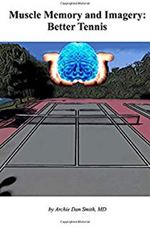Understanding Muscle Memory:
Part 2
Archie Dan Smith, MD

In my first article I said that 3 weeks of muscle memory practice every other day is the optimal period to consolidate new muscle memory.
This means practicing on one stroke or shot, trying to hit several hundred high level repetitions, and not practicing any other shot. (Click Here for Part 1). According to the research, this is the time frame and the practice routine needed for the brain to undergo functional change.
Unless you are doing little else but working on your tennis, however, it may be difficult or impossible for you to practice this intensely every other day for 3 weeks. But I believe that--regardless of what may be optimum--you can make significant improvements with less work.
The intensive 3 week plan described in the first article is a generalization. Generalizations apply to large groups. Individuals vary. So what is needed for each individual may be different.
So here is a less ambitious protocol. Practice 3 to 5 times for one week. Again hitting only one shot and not practicing others. 200 or more high quality repetitions.
If you are just picking up the sport, your gain with this less ambitious plan will probably be the greatest. If you have been playing for years, it may take longer to fully form the preferred pathways. This is because the development of new muscle memory paths will have to compete with established memory paths.
But the point is that if you can string together several sessions of muscle memory practice in a short period of time, you will see real improvement.

Though I have never followed the "ideal" protocol, when I started implementing my theories on muscle memory, I started getting better.
I have completed 5 times of practice every other day a few times. I have also practiced 6 times over two weeks on two occasions. Currently, I do muscle memory practice on one stroke 4 times a week or more once every 2 or 3 weeks.
Now when I am trying to improve, I will practice at least 4 times within one week. I continue to make progress when I commit to at least 4 times in one week, even if it is once every 2 to 3 months. When I do this, the improvement is greater and stays with me longer.
Because of my work with muscle memory practice, I have definitely improved at a faster rate than any of the previous practice routines I had tried--and it has stayed with me longer.
I was a mid-level 3.5 player but I could tell over time my game was slipping, despite taking lessons, going to clinics, playing about 3 times per week, and hitting against the ball machine. I figured that is just how things are when you get older.
Using muscle memory practice, I clearly have gotten better, while most others have not, in spite of my genetic material and age. I am exactly the opposite of a "natural athlete". I am short, small, slow, weak, lacking in coordination and fast reflexes. I am also currently age 67.
Over the past year, I have been ranked #1 in Texas for men 3.5 all ages, and #1 in men's 3.5 doubles age 50 and above. Now I can hit comfortably with 4.0s. I also routinely play with or against players who were college scholarship athletes. This all seems quite remarkable to me--practically impossible. But it's true.
So I say shoot for the ideal, but accept what you can do, and tailor your exact practice schedule and routines to the realities of life.
Transference
If you are intrigued by my approach, you may nevertheless have doubts about working so intensely on one stroke at a time. You may feel you are neglecting or hurting the rest of your game if you focus on, for example, only the forehand.
The reality is that is usually not the case. Surprisingly it can actually be the opposite. In fact, if you only hit forehands you may find that even though you did not hit any backhands, your backhand actually improved. From personal experience, when I was working on my forehand crosscourt and did not hit any backhands or volleys, both my backhand and my volleys also improved.
How could that be possible? There is scientific evidence that explains it. The principle is called positive transference. This means when you practice one skill, improvement occurs in related skills.
This positive transfer occurs because of the strong cognitive component in developing muscle memory. When one skill set is learned, the acquisition and consolidation of the second skill set is easier.
Why? Skilled motor tasks, especially in tennis, have an anticipatory component that is separate from the motor task itself. The ball is coming toward you. You anticipate and calculate the angle, trajectory speed, and spin. None of this is a motor action. It is cognitive.
The critical aspect is starting the movement at the right time with the right focus on the incoming shot. And the brain can transfer this new anticipatory knowledge to a different situation that was not specifically practiced.
The skill sets you learned when hitting your forehand are now available. They are already present when you begin hitting your backhand. So your positive performance in hitting your forehand is now positively influencing your backhand and volley.
Technique Transference
But I also believe that some components of actual stroke technique can be transferred directly from the forehand to backhand side, and vice versa. In my experience when I started developing muscle memory, I started hitting the sweet spot more. I also focused on a smooth swing and following through.
My other strokes improved because I was improving the fundamentals which apply to all strokes. In fact, one study showed that up to 70% of the improvement in one skill can transfer to another--without actual practice of the second.
So don't worry excessively that you are spending all of your practice time on only your forehand for 3 weeks. You may be surprised that your other strokes will not suffer, and could actually improve. My research and my personal experience convince me that this is a powerful process that can make a huge difference in your results and your enjoyment of tennis.





